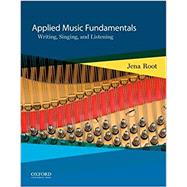Applied Music Fundamentals: Writing, Singing, and Listening provides an engaging and interactive introduction to the fundamentals of music theory. A wealth of skills-based exercises and memorization strategies-both in the text and online-build mastery and fluency through varied repetition and offer students the opportunity to apply musical abilities and concepts. Through familiar examples and by placing the analysis and creation of music in a real-world context, Applied Music Fundamentals moves readers beyond mere rote memorization toward a thorough and more intuitive understanding of the key concepts that music theory students must know.
Distinctive features
* Keyboard, Singing, and Hearing Exercises reinforce the crucial connection between sound and notation
* "Informed Listening" examples challenge students to analyze repertoire by ear in order to foster real-time musical understanding
* Short, portable "Drills to Go" help to reinforce skills and content outside of the classroom
* "Composition" exercises and "Challenge" examples give students the opportunity to think beyond the foundations introduced in each chapter and apply their acquired musical skills in a creative and personal way
· Marginal icons direct students to interactive musical examples on the book's website (www.oup.com/us/root), underscoring how listening helps them understand musical concepts
Instructors: Help your students practice and master basic music theory skills with Oxford's online Music Theory Skill Builder. Specially priced packages are available for this text. Contact your Oxford University Press representative for more information.








